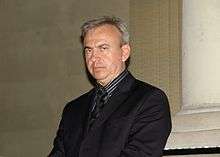Yury Bandazhevsky
| Yury Bandazhevsky | |
|---|---|
 | |
| Born |
January 9, 1957 Belarus |
| Known for |
Work on radiation effects after the Chernobyl disaster and subsequently Amnesty International prisoner of conscience. |
Yury Bandazhevsky (Belarusian: Юрый Бандажэўскі / Juryj Bandažeŭski, Russian: Юрий Иванович Бандажевский / Yuri Ivanovich Bandazhevski; born on January 9, 1957 in Belarus, former director of the Medical Institute in Gomel (Belarus), is a scientist working on sanitary consequences of the Chernobyl disaster. He was the first to create an institute in Belarus, in 1989, specially dedicated to scientific work on the 1986 Chernobyl disaster.
Background
In 1978, Bandazhevsky married Galina Bandazhevskaja, a medical doctor specialized in pediatrics. He studied at the Medical Institute of Grodno and became a specialist of anatomic pathology. He supported his doctoral thesis in 1987, a year after the Chernobyl disaster, and named director of the Central Laboratory of Scientific Research. In 1990, he was named director of the Gomel Medical Institute.[1]
Imprisonment
On June 2001, Yury Bandazhevsky was sentenced to eight years imprisonment on the grounds that he had received bribes from students' parents. The institute's Deputy Director, Vladimir Ravkov, also received an eight-year prison sentence. Bandazhevsky's lawyer claimed that he had been convicted on the basis of two testimonies made under duress, without any material evidence. According to many human rights groups Dr. Bandazhevsky was a prisoner of conscience. Amnesty International has stated on their website "His conviction was widely believed to be related to his scientific research into the Chernobyl catastrophe and his open criticism of the official response to the Chernobyl nuclear reactor disaster on people living in the region of Gomel." His arrest came soon after he published reports critical of the official research being conducted into the Chernobyl incident, and was issued by presidential decree N21 On Urgent Measures for the Combat of Terrorism.[2]
Yury Bandazhevsky was released on parole from prison on August 5, 2005, and prohibited for five months of leaving Belarus. He was afterward invited by the mayor of Clermont-Ferrand, in France, to work at the university and at the hospital on Chernobyl's consequences. Clermont-Ferrand has been since 1977 linked to Gomel where Bandazhevsky used to work. In France, he is notably supported by the Commission de recherche et d'information indépendantes sur la radioactivité (CRIIRAD).
Scientific works
Caesium-137 levels in children's organs were examined at autopsy. The highest accumulation of Cs-137 was found in the endocrine glands, in particular the thyroid, the adrenals and the pancreas. High levels were also found in the heart, the thymus and the spleen.[3]
See also
- Liquidator (Chernobyl)
- Chernobyl Children's Project International
- List of Chernobyl-related articles
- Christopher Busby
References
- ↑ Interview du Professeur Yuri Bandazhevsky, at Minsk, April 2000 (French)
- ↑ "Belarusian Professor Studying Chernobyl Consequences Remains In Prison". bellona.org. (Archive)
- ↑ Chronic Cs-137 incorporation in children’s organs Swiss Med Wkly 2003; 133: pg 488–490. .
External links
- ProgettoHumus: Section dedicated to Yury Bandazhevsky - Bio, Info, books
- The Council of Europe's Political Affairs Committee resolution on Belarus — see section 28, 29 Repression of opponents – Bandazhevski case